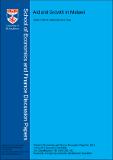Aid and growth in Malawi
Abstract
We study the local impact of foreign aid to constituencies and districts in Malawi over the period 1999--2013 using a highly detailed new aid database that includes annual disbursements at each project location. First, we show using household panel surveys that growth in light density is a good proxy for growth in per capita consumption. Second, we introduce a new political dataset that permits novel instrumental variables. Using two instruments, together or separately, we find a consistent, robust and quantitatively significant role for aid in causing growth in light density. Constituency-level regressions point to a larger effect than at district level, suggesting that aid causes some relocation of activity across space but not enough to make the net effect zero. The impact on growth peaks after two to three years but then falls to zero, implying that foreign aid has a level effect on incomes but does not stimulate sustained growth. Bilateral aid appears to be better in causing growth than multilateral aid. Aid delivered as a grant has an impact while that given as a loan does not.
Citation
Khomba , D C & Trew , A 2019 ' Aid and growth in Malawi ' School of Economics and Finance Discussion Paper , no. 1612 , University of St Andrews , St Andrews .
ISSN
0962-4031Type
Working or discussion paper
Rights
Copyright (c)2019 the authors
Description
Revised June 2017, March 2018 and Feb 2019Collections
Items in the St Andrews Research Repository are protected by copyright, with all rights reserved, unless otherwise indicated.

